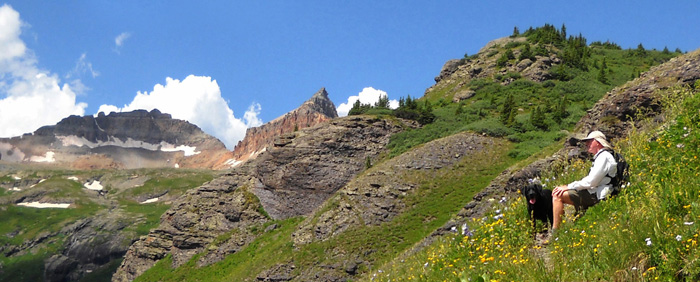Runner accountability for safety's sake: that's the primary
purpose of radio communications during a race in a remote area like the
one in which Hardrock is run. It's easy to get off-course and "go
missing" for several hours in this event, especially at night. One of
the most difficult calls a race director (RD) has to make is whether to
call out Search & Rescue to hunt for a missing runner.
S&R services don't come cheap.
As in some previous years at Hardrock, the radio folks, RD Dale
Garland and his staff, and local Search & Rescue personnel were highly
concerned about at least two runners for several hours on Friday. Jim and I were mesmerized by the action behind the scenes because
we know one of the runners. More about that later.
WHO'S ON FIRST?
One of the advantages of being part of the communications team at an
event like Hardrock or Leadville is to have the opportunity to hear the
radio traffic while we are working our shift. Not only were we able to
hear part of what transpired during the "why race directors get gray
hairs" missing-runners adventure on Friday night, we also heard
information from nearby aid stations about runners' times in and out,
who was in the lead, who dropped, etc.
Information is transmitted by bib numbers, not names, so we had to
frequently consult our alphabetical list to follow the progress of
friends whose numbers we couldn't remember.
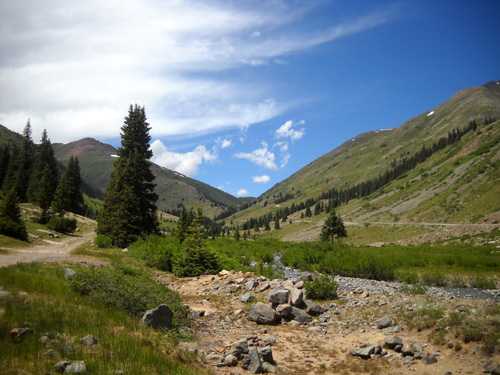
View north from Grouse Gulch aid
station; runners come down the road on the right from Engineer Pass.
If you thought times are tracked in and out of aid stations
primarily for the benefit of crews or so runners will have accurate
splits after the race or to make sure everyone runs the official course
. . . you'd be wrong. While useful, those reasons are all
secondary to the safety of the runners. In addition to runners who have
"gone missing," reliable radio communications between remote aid
stations (particularly ones with no phone signals) and headquarters are
critical if there are serious injuries or illnesses like HAPE or HACE*
that require a runner to be transported for medical care.
[*High Altitude Pulmonary Edema and High Altitude Cerebral Edema,
neither of which you ever want to experience.]
Hardrock has communications down pat. The volunteers who place and
maintain the repeaters on high peaks, the ones who carry their equipment
to remote pack-in stations like Pole Creek and Kroger Canteen (Virginius
Pass), the hams who have manned their aid stations for a decade or more,
the folks who receive the information at headquarters -- these
are some dedicated people, and most of them aren't even runners.
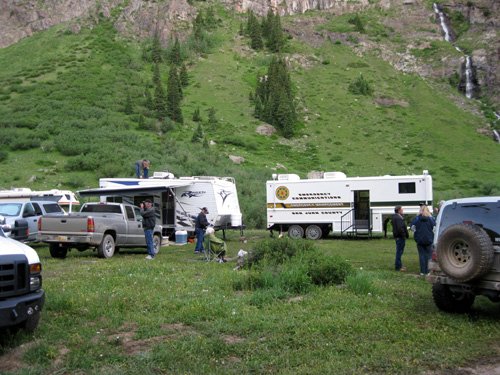
Part of the large communications
team at Cunningham AS in 2009; some of the ham radio
and timing volunteers were in training and were deployed to other aid
stations later in the race.
In addition, the Hardrock volunteer coordinators and staff do a great
job of communicating a ton of information to both volunteers and runners
on the race website. Check out these detailed online pdf manuals for the
runners/crews/pacers,
aid station volunteers,* and
communications volunteers
If any of these groups of
people are clueless about their responsibilities at Hardrock, they
haven't done their homework. This has got to be about the most complete
compilation of pre-race-specific information in ultra-dom! I like that.
Other events would be wise to start transmitting as much useful written
information to their participants via their websites.
[*A/O October, 2010 when I'm writing this, the volunteer manual is
for 2009 but the information is mostly valid. If that link doesn't work
when you read this, go to the
home page and click on the volunteer
link.]
COURSE LAYOUT & AID STATIONS
As mentioned in the last entry, we chose to work with ham radio
communications at the Grouse Gulch Aid Station as our major volunteer
job this year. We became interested in assisting more with the "comm"
team after learning how they do their jobs at the race in 2009. It's a
nice break from doing traditional aid station tasks, which we've done
for 30+ years at road and trail races.
There are thirteen aid stations for runners when the
race is run in the clockwise direction (Silverton to Telluride to Ouray
to Silverton) as it is this year, fourteen in the CCW direction when
Putnam Basin becomes a pack-in station near the end of the race when
runners need more support.
Here's the "big picture" of the course:
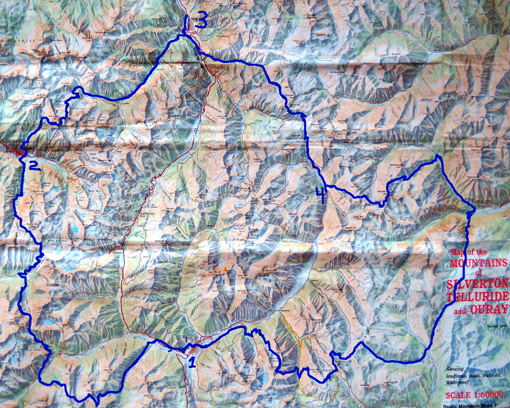
I simply took a photograph of part of the large Drake Mountain Map of
the San Juan Mountains that is used by race management and the runners. I know
you can't read any of the wording on this small map but you can see the
course configuration (the blue loop) and the three towns through which
the runners pass. Number 1 = Silverton, #2 = Telluride, and #3 = Ouray.
Number 4 is the location of the Grouse Gulch aid station, which is 58.4
miles into the course this year in the clockwise direction.
For course details, check this
page on the race website. The course is
divided into seven map segments so the pages are easier to open. This is
a closer view of
the segment runners followed from the town of Ouray to our station at
Grouse:
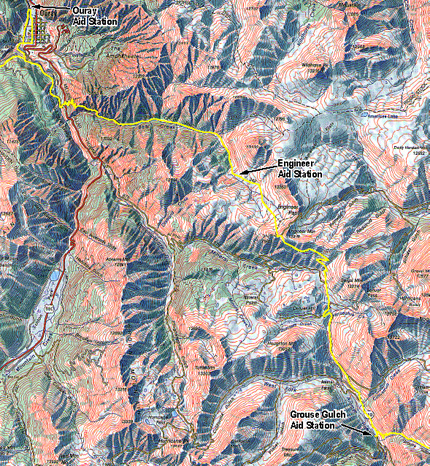
The largest and best-supplied aid stations are the three that are
located in Silverton, Ouray, and Telluride; Silverton serves as
the start/finish and race headquarters. Seven of the aid stations are
more remote, including ours at Grouse Gulch. Some of these seven can be accessed with 2WD vehicles, others only with
4WD. Four of the stations are so remote that they can be reached only on
foot or with pack animals. Those have the fewest volunteers and supplies
for the runners, but even those have ham radio volunteers to facilitate
the safety of the runners.
In previous years we've volunteered primarily as either co-captains
(2006-2007) or helpers (2009) at the Cunningham AS. I also assisted at
Grouse and Ouray when Jim was pacing a runner last year and Jim helped
with communications at headquarters in Silverton.
We've done several additional volunteer jobs before the race those years and in
the early 2000s. This is our fifth year to volunteer at Hardrock.
Since we've driven out to Grouse Gulch twice previously we already
knew the aid station layout -- and how cold it gets so close to
the north fork of the Animas River at night! That helped us prepare for our long vigil
this year.
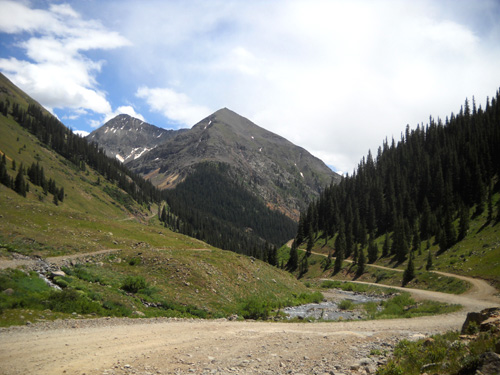
The road to Grouse Gulch, looking
back from the location of our aid station
In 2007 we
had lots of food and supplies left over at Cunningham Gulch on Friday morning (we were the first aid station that year in the CCW direction).
The aid station coordinator directed us to take some of our leftovers to
Grouse and return some to HQ. Then last year when Jim paced a runner from
Grouse to Ouray in the CCW direction we spent a couple hours waiting for
him at Grouse and got more familiar with the "lay of the land," although
it was dark when we were there.
We quickly discovered this year that the bulk of the runners also
come through in the dark in the clockwise direction. That made it hard
to see how friends were doing and was the main disadvantage of this
particular aid station in a CW year.
SHOW TIME!!
The race began at 6 AM Friday. Although we've watched the start a few
times, this year we slept until about 8, knowing we'd
be up all night working the radio. We did our own run and hike that
morning, ran some
errands in town, fixed lunch, and finished getting all our things ready
for an anticipated 24-hour shift at the aid station. Including transit
time and other preparation, it was at least 24 hours.
Around 1:30 PM we met Paul and Jigger, the couple in charge of ham radio
operations at Grouse Gulch for the past dozen years or so, at the gym in
Silverton. After catching up on the latest runner news from the
communications folks at "Net Control" (ham-speak for headquarters), we
followed Paul approximately seven miles out to our aid station.
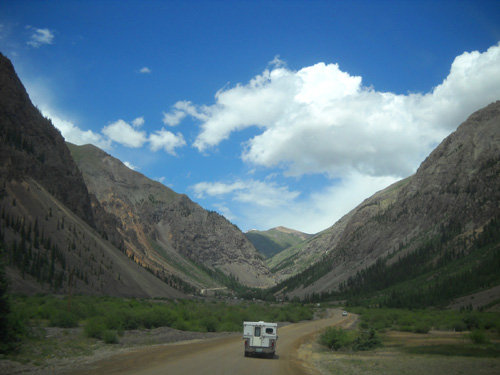
Following Paul and Jigger's
camper truck toward Eureka on the road to Grouse;
this is typical San Juan Mountain scenery. We're
over 10,700 feet elevation here in this valley.
One of the reasons we chose this aid station is its relatively close
proximity to Silverton. That doesn't mean it's easy to access, however.
We no longer have a 4WD truck so the condition of the road was one of
our criteria when choosing a location to work.
The first couple miles out of town on CO 110 aren't bad for a dirt
road; it's two lanes wide and fairly smooth. It gets a little rougher
and more narrow on the next couple miles on the Engineer Pass Road (part
of the Alpine Highway) from the
intersection with the road to Cunningham Gulch at the former mining
town of Howardsville.
The road deteriorates further after crossing the Animas River at the old
Eureka mine site, which is just ahead of us in the photo above.
Volunteers, crews, and tourists don't need 4WD to reach Grouse Gulch but
they need to be ready for about three miles of very narrow roadway with
lots of rocks, ruts, and blind curves as they follow the river's north
fork upstream:
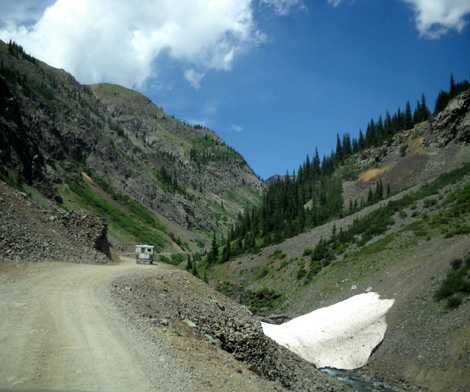
The Animas is more like a creek at this point but it gains
volume quickly downstream after the south fork joins in at
Eureka.
Like just about every road in the San Juan Mountains, this one
is scenic even though it courses through the valley in this
section and doesn't go over a higher pass like it does in a few
miles at Engineer Pass or Cinnamon Pass. "Valleys" in the San
Juan Range are pretty high up themselves; the elevation at
Grouse Gulch is a lofty 10,710 feet.
Some "valley," eh?
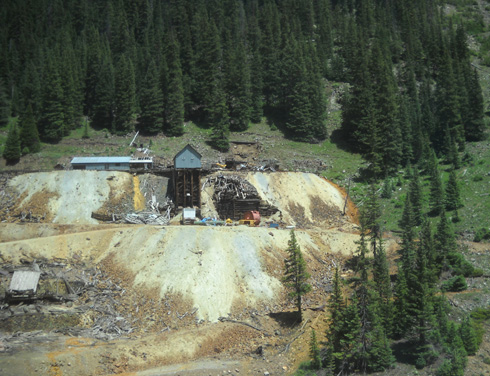
The road was originally used to access mines (see one above) before it
became a tourist loop for Jeeps and other 4WD vehicles. Runners,
crews, and volunteers must share the road with these folks on
race weekend, but most of the non-race participants are
considerate when they see the runners on the road between
Engineer Pass and Grouse Gulch. Many stop at the aid station to
ask what's going on, and are most impressed when they learn that
140 runners are attempting to run a hundred miles at high
altitude in these mountains!
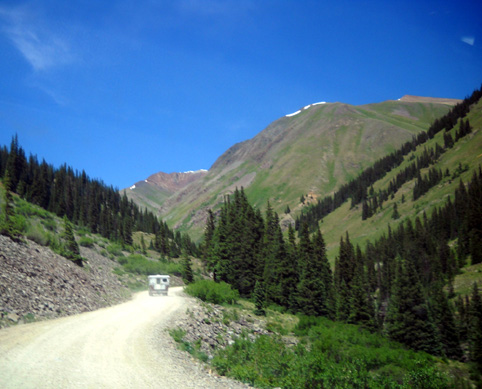
Almost there; what a pretty day!
STAKING OUT OUR TURF
When we arrived at Grouse Gulch about 3 PM the aid station
captain and his first round of volunteers were already set up
and waiting for the runners. Some brought tents so they
could work all night or in two separate shifts separated by a few
hours of sleep.
Paul knew just where he wanted to park his truck camper between
the AS tent and the river. We parked our truck behind and above
him on a bank facing the road where runners would enter and
leave the aid station. I'll show several views of the aid
station throughout this entry.
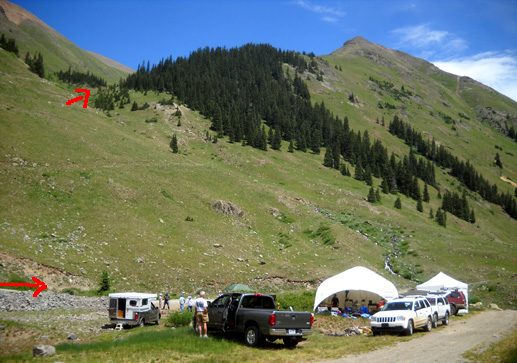
Runners enter and leave the aid station on
the road to the left (horizontal arrow), then head
up the mountain on switchbacks (top arrow)
toward American Basin and Handies Peak.
Our gray Ram 2500 truck is in the
foreground; Paul's camper truck is below us to the left.
It was a good spot with a view of the road, aid station, and
surrounding mountains. Too bad it was dark so much of the time
we were there!
Paul's camper in the bed of his truck served as our small team's
ham radio headquarters for all but a few hours during the night
when he slept and Jim manned his own radio in our truck.
Jim's a ham operator; I'm not, so I couldn't officially
transmit information over the radios but I could help them
listen for and record information and do other tasks I'll explain in a minute.
I spent most of my time with Paul and/or Jim either in the camper
or our truck.
Two other couples worked in shifts to help Jigger record
runners' times in and out of our aid station. They were set up
near the road and along the path the runners used to get to and
from the AS tent. Jigger was out there in the cold, under a
canopy, the entire time the aid station was open, but she
remained perky and efficient the entire time. She clearly loves
that job.
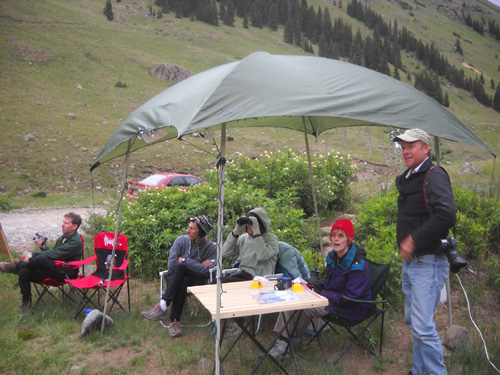
Jigger (red hat), volunteers, and crew
members react as the first runner is spotted up the road.
I enjoy doing timing, too, but under different circumstances and
for a shorter shift. After enduring a long, sedentary,
bone-chilling night doing timing at Bandera in January I vowed
I'd never repeat the experience!
As soon as Paul and Jim got their radios set up, and long before
any runners reached our aid station, they began listening to the
radio traffic between headquarters and the other aid stations on
our frequency.
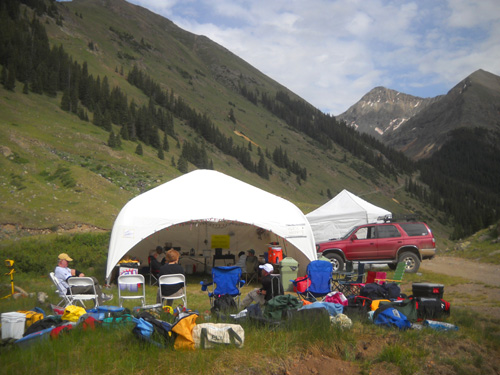
Above and below: volunteers relax while waiting for the
first runners to appear at Grouse.
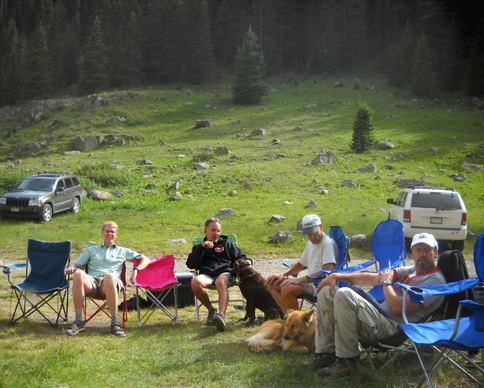
I took the opportunity to hike with Cody about a
mile up the trail runners would be using to reach American Basin
and Handies Peak after leaving Grouse. With all the switchbacks,
the grade from 10,700+ feet at the aid station to 14,000+ feet
on Handies isn't too severe but it's a haul. I got high enough
that the aid station looked very tiny from my perspective along
the trail. A couple of those photos are shown farther below.
WILL ALL THE MEN GET "CHICKED" THIS YEAR?
When I got back down to the aid station at 4 PM Jim and Paul were
eagerly listening for information about the location of the
front runners.
At 4:01 two runners entered and quickly left
Ouray, two aid stations and 14.5 miles before ours. Even as fast
as Diana Finkel and Nick Pedatella were moving, it would be
several hours before they reached Grouse.
Diana Finkel???
A woman, indeed! In close second behind Jared Campbell from
Chapman (18.9 miles) to Governor Basin (36 miles), Diana
overtook the lead and Nick caught up to her by the Ouray aid
station at 43.9 miles! We wondered if or how the lead would
change by the time they reached us.
Cool!! This made the race more exciting for everyone
watching/listening. Maybe all the guys would get "chicked" this
year! A female has never won Hardrock outright, even when Krissy
Moehl obliterated the previous women's record in the other
direction. Last year Diana came in third overall; Jared was
sixth.
This could get quite interesting! Hearing the times in and out
of the other aid stations is definitely one of the best reasons
to work the radios during a race.
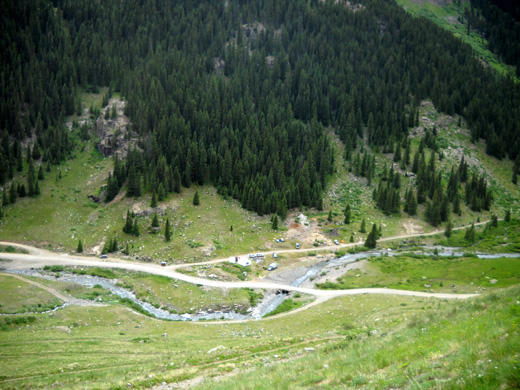
Bird's-eye view of our aid station from the
switchbacks going up to Handies Peak;
that's the Animas River flowing by the aid
station.
As soon as the first runner reached Engineer Pass, the aid
station right before ours, we listened intently as the ham
called in the times to HQ in Silverton. Jim and
Paul began writing down the runners' times OUT (not in) so folks
at our aid station could estimate their arrival. Although it was "only" a 6½-mile
downhill run/walk to our station -- one of the shorter
and easier sections on the course --
it was still 50+ miles into a grueling, high-altitude race and
it took some of the slower runners over three hours to reach us.
Guess who clocked into (and OUT of) Engineer Pass first at 6:24
PM -- Diana!! Nick arrived about two minutes later and
stayed about four minutes. I think everyone at our aid station
was saying either out loud or to themselves, "Go, Diana!"
except for Nick's, Jared's, and Karl Meltzer's crews!
CREW = CRANKY RUNNER, ENDLESS WAITING
Grouse Gulch is a popular crewing point in the race because
crews don't need a 4WD vehicle to reach it and they don't have
to lug their runner's supplies very far from where they park.
Although it's a long drive for them from their last crewing
point in Ouray, they can get there a lot faster than their
runner. It's also a point where some pacers pick up their
runners.
Consequently, there are lots of crew members and pacers hanging around
this aid station for
several hours, all anxiously awaiting their runners' arrival. I
can surely empathize with them. As many times as I've crewed for
Jim in races, I know how valuable it is to know when he's left
the previous aid station so I can better estimate when to expect
him.
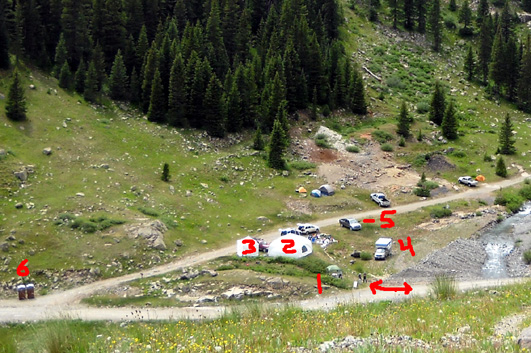
Closer view of Grouse Gulch AS:
arrows = runner entrance/exit, #1 timing canopy,
#2 aid station tent, #3 medical tent, #4
Paul's camper truck, #5 our truck, #6 two porta potties
Paul and Jigger have a successful system at Grouse to keep crews
and pacers informed about their runners and virtually eliminate individual
runner inquiries that can take valuable ham radio time and air
traffic: they set up a wooden "sandwich"
(message) board near the
timing canopy and write down the runners' times OUT of Engineer.
Crews can
simply find their runners' number to see when/if they left the last aid station
and estimate the time it will take them to reach ours. They have
little need to bother either the timers or radio operators. In
fact, at Hardrock (unlike Leadville, where we've done a similar
job) they are told not to ask the ham radio folks about
their runner. Some folks did express concern about the time it
was taking for their runners to reach Grouse from Engineer, but
the nearby timers dealt with that and everyone who was expected
did make it to our aid station before the absolute cut-off on
Saturday morning.
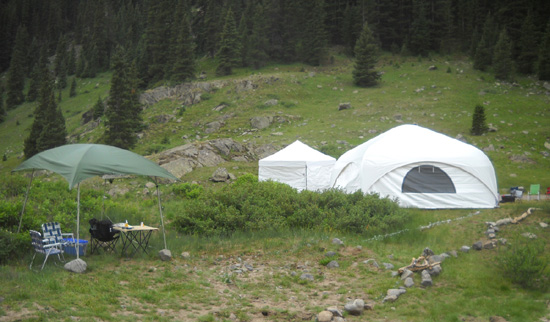
Timing area (L) and path to/from the aid
station tents
I don't know if posting OUT times from the previous aid station is standard operating practice at the other
HRH aid stations or used in other races but it's a win-win for
crews and communications people and I highly recommend it.
Every time Jim or Paul heard the communications person at
Engineer transmitting times IN and OUT over the radio to
headquarters, they wrote down the numbers and OUT times on a
sheet of paper. Times out were the only ones relevant to us.
When we had a list of ten or fifteen numbers, I hopped out of the camper
and walked them over to the board, where I wrote them down for
the crews to see.
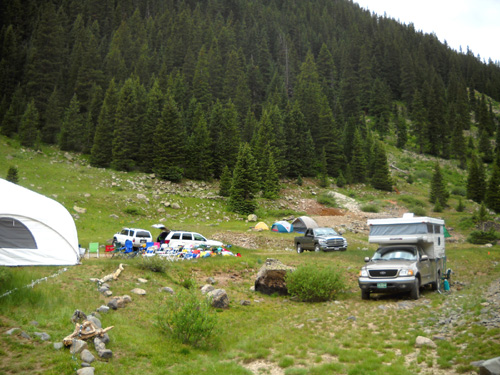
View farther to the right, showing runners'
drop bags, our truck, and Paul's truck camper.
A group of crew members would gather around me every time I
appeared with new names. They appreciated the information and it
gave me more of an opportunity to interact with them and the
runners who happened to be arriving at or leaving the aid
station. We couldn't see the runners from inside the camper very
well, especially after dark -- and most of them
arrived after dark.
Crews at Hardrock also have the opportunity to check their
runners' status online during the race if they have a laptop
computer with them or at their place of lodging. Most of the aid
stations don't have internet connectivity but crews can access
the internet in and near Silverton, Ouray, and Telluride. They
can also check the computer screens at HQ when they're passing
through Silverton to get from one part of the course to another.
That's a popular gathering place during the race.
GREAT EXPECTATIONS
I was about as excited as anyone else at the aid station,
barring the front-runners' crews, as the time approached that we
estimated the first runners would appear at Grouse. I stood out
at the road near the timers as I peered up the dirt road toward
Engineer Pass, hoping Diana would still be in the front.
Chicks gotta stick together!
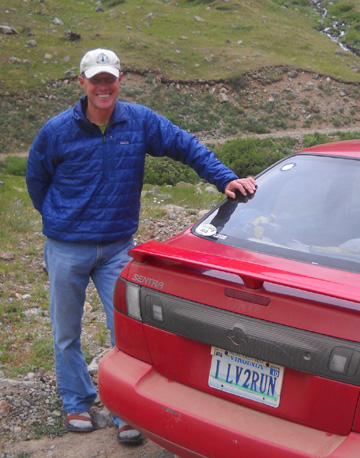
I was surprised when David Horton (above), one of my favorite ultra
people, came over and gave me a hug; I wasn't expecting
him there. We didn't have long to talk so I'm not sure if he was
crewing, pacing, or just spectating the race. David used to have
the course record in one direction. That's one of many ultra
running achievements in his repertoire.
You can see the excitement on spectators' faces as someone with
binoculars spotted the first runner far up the road, then
identified the runner as Diana:
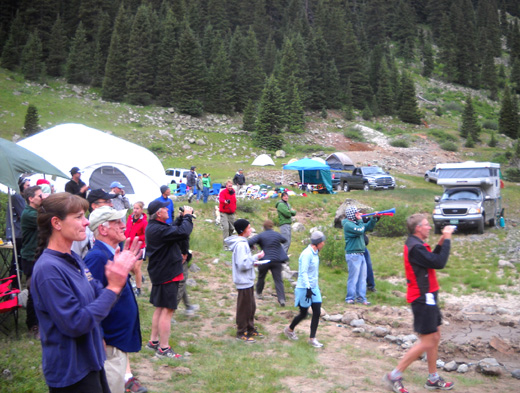
I had as much fun watching her proud parents (below) as I did
watching the smooth transition Diana and her pacer made at the
aid station:
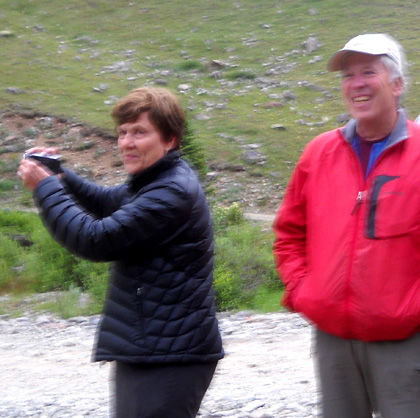
Diana's parents
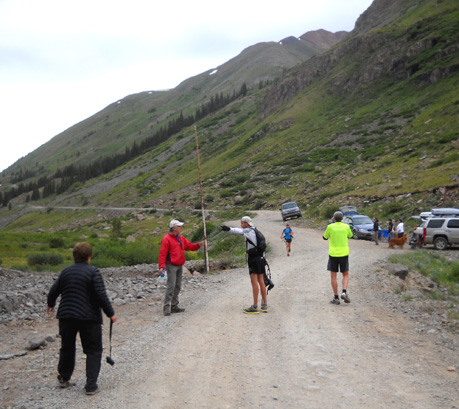
L-R: Diana's parents, her pacer (in
white shirt) giving instructions to her dad,
Diana (in blue top, running down Engineer
Pass Road), and crews of other runners
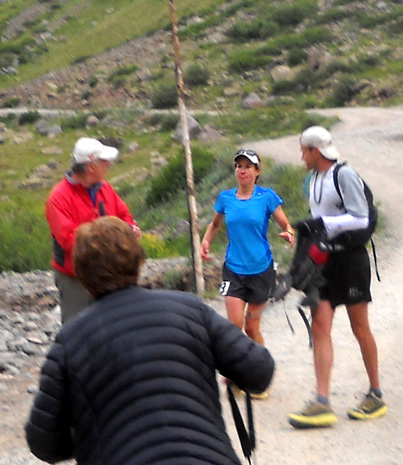
Diana looked strong at 58+ miles and had a
big smile on her face. (The pole sticking
up along the side of the road is to show
folks where the side of the road is
when there are ten feet of snow covering
the valley in the winter!)
Diana checked in with the timers but was out in a flash
with the gear and supplies she'd need in the next 13.4 miles
over Handies Peak and on to the Sherman AS. That's the longest
distance between any of the aid stations at Hardrock and it's
during the night for the many of runners, so they need to be
well-prepared.
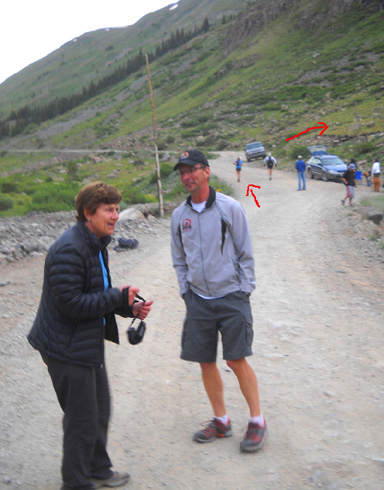
Diana's mom talks with RD Dale Garland as
Diana and her pacer
(lower arrow) head for the trail up to Handies Peak (upper arrow).
Nick Pedatella came in about fifteen minutes later and spent
several minutes in the aid station before checking out at 8:06:
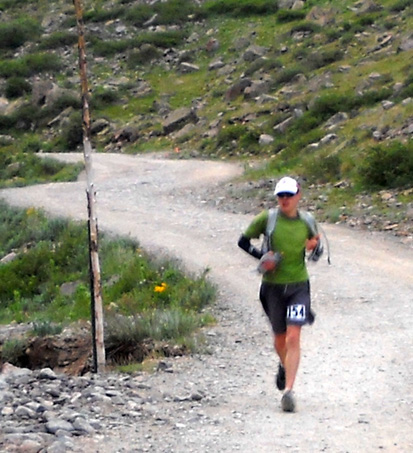
Nick charges into Grouse Gulch.
Jared Campbell was third, arriving at 8:15 and leaving
four minutes later:
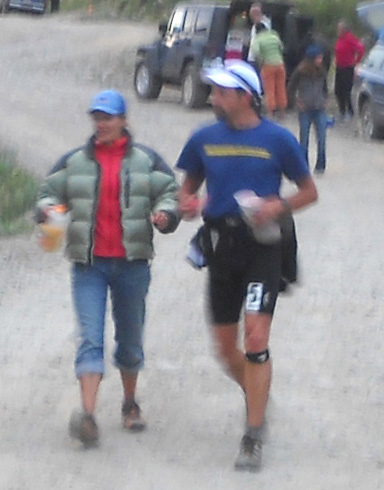
Jared talks with his crew person as they
walk toward the aid station.
Diana had a sizable lead on both of them but a lot can happen in
a race like this.
I returned to my duties after Jared came in and didn't get any
more photos of runners coming into the aid station.
Karl Meltzer, who has previously won the race five times and
holds the course record in the other direction, came in fourth
but decided to drop at Grouse. He's been injured several times
this year, including a broken arm and bruised ribs. He came into
this race with a still-healing broken clavicle. I think it's
remarkable he did as well as he did for over 58 miles!
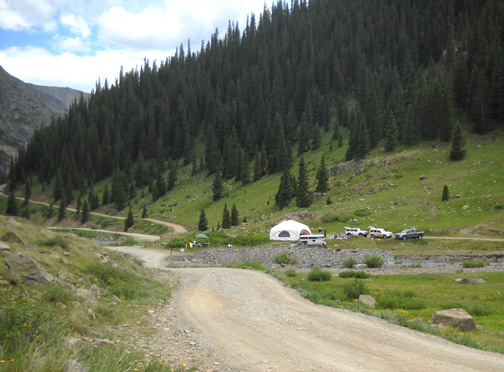
Runners' daylight view approaching Grouse
The trickle of runners didn't peak at Grouse for several hours. Even the
"bubble" was spread out from about midnight to 5 AM on Saturday.
The average 48-hour time for runners to reach Grouse was 7:30 AM
on Saturday; after that, it was unlikely they'd reach Silevrton
by 6 AM on Sunday. The absolute cut-off at our AS was 10:30 AM
on Saturday.
SILVERTON, THIS IS GROUSE . . .
Once runners began coming into Grouse Gulch, Jigger and her timers
meticulously kept track of them on the race's standardized timing sheets as
they entered and left the aid station on the narrow path by the
timing canopy. Jigger would either call a group of their numbers and times
in and out to Jim and
Paul or she'd send the list back with me for them to report to
Silverton.
I was a "runner" of sorts, carrying information to and fro. The
job didn't take much brain power but it made me happy to be able
to move around to socialize a bit and to keep warmer. Paul's
supply of propane in the camper ran out shortly after dark so it
was nearly as cold inside with Paul and Jim as it was outside under
the timing canopy.
The warmest places at Grouse on Friday night were the aid
station tent and the roaring wood fire outside. Just ask the
crews!
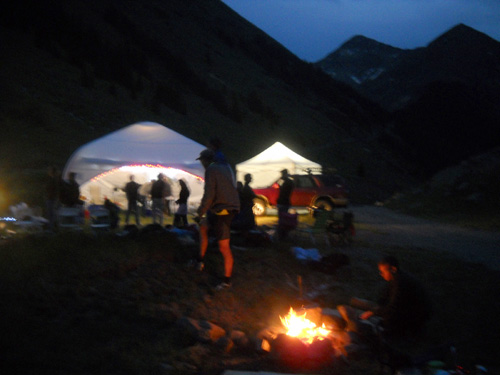
When Jim and Paul had about ten runners' numbers and IN/OUT times
at our aid station they called them into headquarters over the
ham radio system. They had to compete for air time with the hams
at other aid stations doing the same thing. At that point in the
race, runners were spread out over many miles of the course. Net
Control can talk to only one person at a time on each frequency.
Some aid stations used computerized "packets" to report the
times, which eliminates a lot of voice traffic over the air.
Paul prefers to use traditional ham radio techniques at Grouse.
That's not as efficient as packets but more fun for Paul and
some of the other hams. If it wasn't satisfying, they wouldn't
keep coming back to help.
As runner numbers/times in and out of the aid stations were
called in, communications volunteers at HQ posted the information on the race
website. Folks with computer access anywhere in the world (or
much closer, in the gym itself or at an aid station with connectivity along the race
course) could follow the runners' progress in fairly
close-to-live time.
You can see the final splits at
this
link. It pretty much looked
like that during the race, only it was being updated constantly.
Paul and Jim called in the numbers of the nine runners who
dropped at our aid station (no one was pulled) and relayed requests for more
supplies from the aid
station captain. They noted the runners who dropped at previous aid stations,
too, so we'd know how many to expect at
Grouse. I don't believe they had to call for additional medical
assistance at our aid station; we had some stationary and roving
medical folks there throughout the race that took care of any
problems.
WHERE'S GEORGE?
The main safety issue with which Jim and Paul assisted was during the
night on Friday when two runners "went missing" somewhere
between the Chapman (about mile 19) and Telluride (about mile
28) aid stations. Volunteers at Telluride became concerned when
the two runners didn't show up after everyone else had long been
gone.
That initiated a lot of radio traffic. It was very interesting
to see and hear some of what goes on behind the scenes when a
runner is missing.
RD Dale Garland was at our aid station watching the front
runners come in when he first learned about the two missing runners.
He was in and out of Paul's camper for several hours,
making/receiving calls over the radio to the hams and aid
station captains at Chapman and Telluride (who had to stay in
position until both runners were located), to headquarters in
Silverton, and
eventually to Search & Rescue when it was over ten hours
since one of the runners had last been accounted for.
Fortunately, one of the runners finally ended up back at Chapman
and the other one reached Telluride just before midnight. All
the other runners had cleared Telluride by about 7 PM, so you
can understand why folks were concerned.
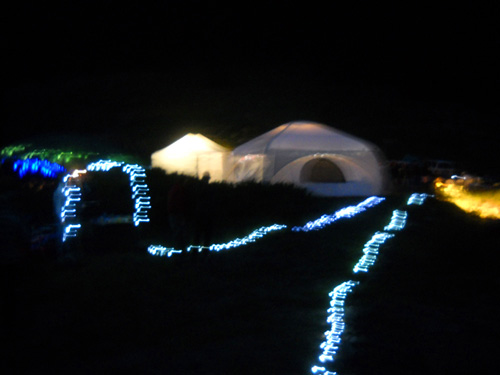
This blurry night shot of our aid station
appeals to me more than the less-blurry ones.
We were particularly interested because we know one of the
runners who was involved, George Velasco. He's the one who
didn't get to Telluride until almost midnight. He was later commended by race officials for trying to find and assist
the other runner, who George heard (from a third runner) was
injured, disoriented, and possibly off-course between Oscar's
Pass and Telluride.
George
knows how dangerous these mountains can be after dark -- especially if you're injured and possibly
disoriented and/or lost -- and he was conscientious
enough to sacrifice his own race in an effort to help the other
guy. He went backwards to try to find him.
Because of the hours he lost trying (in vain) to help the
other runner, George missed the cut-off at Telluride and had to
drop out.
You don't hear stories like that very often except in
ultra-distance sports like trail running and adventure races, do
you?
I was impressed with how calmly (outwardly, at least) and
thoroughly Dale handled the situation and relieved that both
runners were eventually accounted for, safe and not badly
injured. I don't believe a search was mounted, but it was
imminent.
This incident illustrates how important it is to have a good
communications system operating during an ultra-distance event
in the wilderness. If aid stations have cell phone access, it's
easy to keep track of runners by phone. In a remote area like
the San Juan Mountains, however, radios are required to maintain
contact.
Not all races have as many dedicated communications
volunteers as Hardrock. Some races don't require their ham folks
or aid station captains to remain in place until all the runners
reach the next aid station, either. That makes the
volunteers' shifts longer but it's another important safety
feature for the runners. If no one had been at Chapman when the
injured runner went back to it (he was apparently closer to it
than Telluride), he would have been in a world of hurt in that
remote area on a very cold night.
LONG BUT NOT-SO-LONELY NIGHT
Communications and aid station volunteers kept busy all night at
Grouse since the bulk of the runners came through after
midnight. It was hard to see what was going on from inside
Paul's camper but we could tell from Jigger's IN/OUT reports
that there was plenty of activity going on less than a hundred feet away.
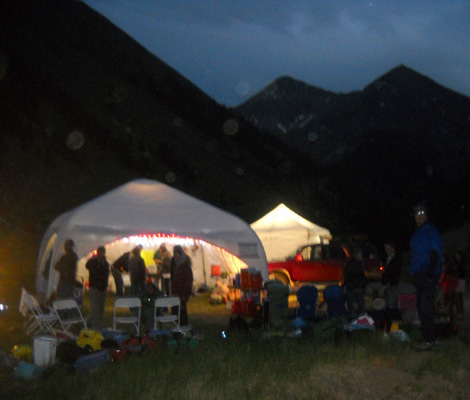
I had periodic contact with runners and crews that we know when
I'd be "running" the lists between the camper and the timing
canopy or taking porta-potty breaks on the other side of the aid
station tent. (This was apparently the first year a portable
toilet was available at Grouse, and we were very grateful for
it. Thank you, thank you, thank you to whomever found the
company willing to haul two potties in and out that rough road!)
I helped Paul with radio communications in the camper from about 3:30 AM to 5:30 AM
on Saturday morning when Jim joined Cody in our truck
to try to get some shut-eye. It was interesting to get to hear about Paul's experiences as a ham radio operator and
instructor, his adventures as a pilot, and his trips to Alaska
(I've given up previous dreams of getting a pilot's license, but
visiting Alaska is still high on my bucket list). I was too
wired on caffeine and the excitement of the race to even attempt
to sleep until Saturday afternoon when we returned to our own
camper.
Soon after Jim woke up and came back out to Paul's camper around 5:30 AM,
our good friends Deb and Steve Pero arrived at Grouse. Steve was
pacing Deb. We were dismayed to see Deb bent over in her chair
inside the warm aid station tent so we went over to talk quietly
with Steve periodically to see how she was doing. She wasn't
feeling so great at that point, although she'd had a good run
through the first half of the race. Steve made sure she got some
rest. Deb later determined she hadn't taken in enough
electrolytes and was having problems with hyponatremia.
We were relieved when she appeared to have recovered
sufficiently to leave Grouse at 8:55 AM and head up the trail to
Handies Peak. I just happened to be out at the timing tent when
she and Steve checked out to the cheers of the volunteers and
remaining crews:
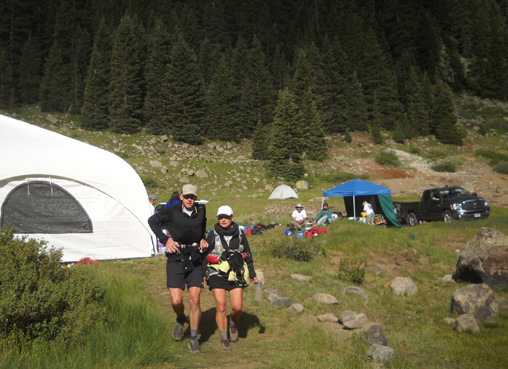
Twenty-three minutes after that, the first runner arrived at the
finish line in Silverton. That's what I'm talking about
re: one of the advantages the communications volunteers have
-- knowing right away, from even a remote location, who won
the race.
No, it wasn't Diana Finkel. Rats. Although she was still leading
the competition by six minutes at the last aid station
(Cunningham) at 91.3 miles, she began having stomach problems
and cramping up. Jared Campbell passed her in the last few miles
and gained a sizeable lead. He finished at 9:18 AM on Saturday,
a cumulative time of 27:18 hours. Diana slowed down but still
finished second overall (possibly the highest female finish
place in race history) at 10:32 AM for a cumulative time of
28:32 hours. Third place Mike Foote was over an hour behind her;
he was in fifth place at Grouse. Nick Pedatella, who was in
second place at our aid station, fell back to fifth place at the
end.
That illustrates my earlier comment that a lot can happen over
the course of a 100-mile race, especially in the second half.
Meanwhile, after Jim woke up Paul took a nap in the back of his camper
(where his radio was) from about 5:30 to 7:30 AM. I joined Jim
in our truck to use Jim's radio during this period of time. Ahh
. . . with the heater on, I was finally warm again! I
could also see what was going on much better out our truck
windows than from inside Paul's truck camper.
This is more like it . . .
By 5:30 AM Saturday there were fewer runners coming into the aid
station and they were farther and farther apart. Most of the
runners had left Engineer by then, so my job of listing times on
the board was almost done. I continued bringing back times in/out of our aid station to Jim so he could relay them to
Silverton, and monitored radio traffic when Jim took breaks to
walk around.
THE SECOND SUNRISE
The "second sunrise effect" is almost as strong for volunteers
and crews who have been up all night as it is for the runners.
There is usually a surge of energy and it's much easier to stay
awake.
After the sky began to lighten up on Saturday morning --
it didn't get sunny in the gulch until much later because
of all the surrounding mountains -- we could see a lot
more of what was going on in the aid station. Too bad we missed
that during the night.
Because most of the runners had already gone through Grouse we
mentally started to wind down and the volunteers began
consolidating their equipment and supplies. Jim continued to
report the times in and out for a while after Paul woke up,
until Paul couldn't stand just listening any more and resumed
calling times to Silverton.
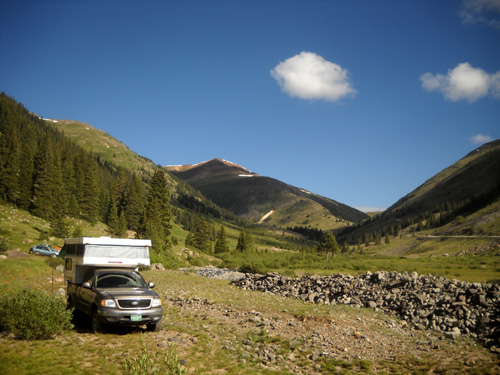
Saturday morning at Grouse: another
gorgeous day to be alive!
Our absolute cut-off at Grouse was 10:30 AM. By 10 AM there were
only a handful of runners who hadn't come in. That's when Paul
suggested Jim and I go ahead and leave on our planned hike up to
American Basin and Handies Peak. I'll write about that in the
next entry so you can see what runners faced the next few miles
beyond Grouse.
The last runner came into Grouse at 10:20 AM. Even though she
was a few minutes ahead of the cut-off, she dropped there. Paul
and Jigger stayed at Grouse with the aid station captain for
several more hours until the last-runner-standing reached the
next aid station (Sherman) a long and difficult 13½
miles later. They were still waiting when Jim and I returned
from our hike.
The last runner checked into
Sherman at 3:55 PM on Saturday. It was HRH veteran Leonard
Martin. He finished the race, but unfortunately he was two
minutes over the official cut-off at the end. As noted on the
race homepage after the race, he displayed "a graceful
acceptance that reminded us all what a gentleman he is."
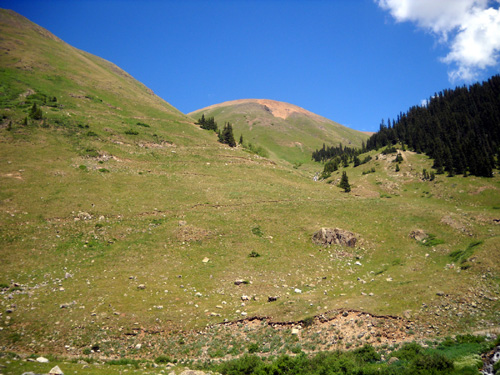
Looking up at some of the switchbacks
going up to
American Basin/Handies Peak
from the road at
Grouse Gulch. The sky looked like this both Friday and Saturday
mornings.
Although it got plenty cold next to
the river in Grouse Gulch during the night Friday/Saturday, the
weather this year may have been the best in race history
for everyone involved. We had none of the usual rain/sleet/hail
at Grouse and I don't think there was much precipitation
anywhere else in the mountains. There was less snow than normal
at the higher elevations, the trails and cross-country sections
were more dry, the streams were lower.
Despite the great weather and
course conditions, the
front-runners were a little slower getting to Grouse Gulch than
the clockwise course record times. However, according to Paul's
records from Grouse two years ago (also in the clockwise
direction), a higher percentage of runners came through our aid station with
faster times this year than in 2008. I also noted at the awards ceremony that
several veteran HRH runners had personal bests on the course
this year.
When Jim, Cody, and I got back down from our hike up toward
American Basin around noon, the aid station tent was still up
but most everything else had been packed up and hauled away.
Paul and Jigger thanked us for our work and sent us on our merry
way. One or both of them remained close to their radio another four hours until
all the runners made it to Sherman.
CAN YOU SEE ME NOW?
We mostly enjoyed working communications at Grouse but would
enjoy it more in the CCW direction at 41.6 miles when more
runners come through in daylight and we can at least see
them (and vice versa). We both prefer having more direct contact with the runners, so a
timing job right next to the entrance into or out of an aid
station suits us better than sitting farther away and being
more isolated from them -- day or night.
Jim had a good experience working with Paul on the radios;
he's a knowledgeable and personable guy. Jim does believe,
however, that it would be more efficient to report the
runners' times via packets from Grouse than calling them in on
the ham radios the
traditional way. He enjoyed reporting from our own vehicle,
which was more comfortable and had a better view of what was
going on.
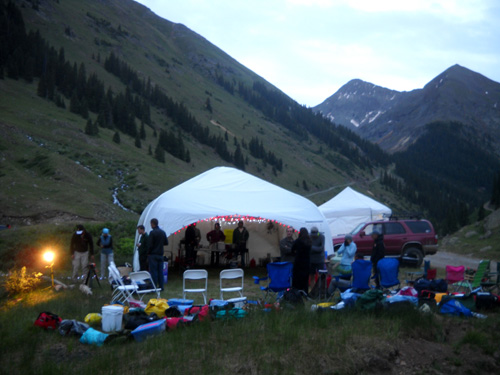
At dusk on Friday night, runners were still
few and far between at Grouse. The bubble came after dark.
These issues make us think more about what might be the "best-fitting"
communications job for us at Leadville in August, as well as
if or where we'd rather be assigned the next time we work the
radios/timing at Hardrock.
It is volunteering, after all, so we may as well have as
much fun as the runners do!
EARLY FINISHERS
On the way back into town we drove a few blocks out of our way
to return some large beverage containers from the aid station to
the ski lodge, which served as the staging area for the aid station
equipment and supplies this year.
The runners come down a trail here and finish up at the gym less
than a mile away.
It was fun to see a couple of the early finishers bomb down that
hill and make their way to the finish line, which is where we
drove next.
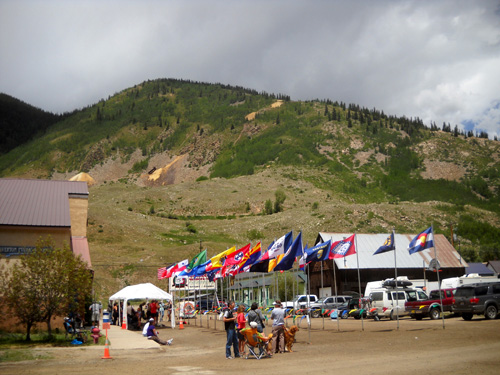
The finish area early
Saturday afternoon; runners would be coming in until 6 AM on
Sunday.
We spotted our friend Marcy Beard right away at the finish --
she expected her husband John to come in soon. After being awake
all (me) or most (Jim) of the night, we were more than a little
tired and sleepy, so we left within a few minutes. I wish we'd
stayed about fifteen minutes longer, however, so we could have
seen John kiss the "hardrock" under the finish banner a minute
before 1 PM. He had a great run this year (30:59 hours),
finishing ninth overall and
missing eighth place by only two minutes. Good job, John!!
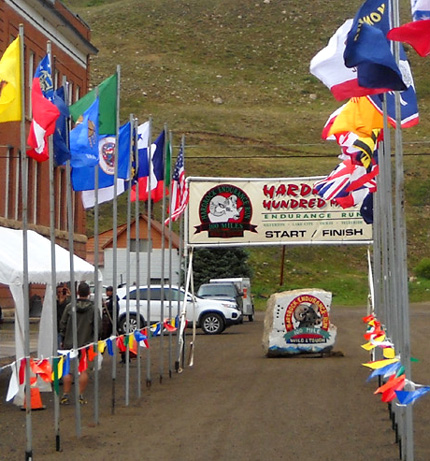
All Hardrock Hundred finishers must kiss
the hardrock at the end of the race -- it's an honor!
When we got back to the camper we got cleaned up, ate lunch, and
took a nap. Oh, it felt good to sleep a couple of hours . . .
After we got up we had fun watching the "live" results on the internet during
the afternoon and evening on Saturday. Results were posted
pretty quickly. We cheered when friends reached another aid
station or came across the finish line. We were disappointed
when we saw that a couple of our friends dropped out or missed
cut-offs after Grouse Gulch, and patiently waited until the
awards ceremony the next morning to find out what went wrong.
When we went to bed at 9 PM there were about thirty
runners still out on the course. They still had nine hours to finish.
Jim and I were so exhausted we slept till 7 AM on Sunday,
missing the final excitement at the finish line.
We aren't 35 any more, after all. We did make it to the awards
brunch at 9, however.
Next entry: our hike on Saturday morning from Grouse Gulch up
toward American Basin; the HRH awards ceremony on Sunday will be the
entry after that
Happy trails,
Sue
"Runtrails & Company" - Sue Norwood, Jim O'Neil,
and Cody the Ultra Lab
Previous
Next
© 2010 Sue Norwood and Jim O'Neil
